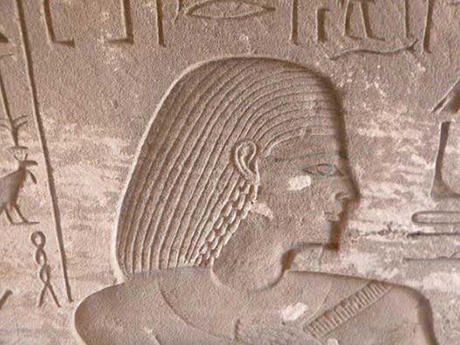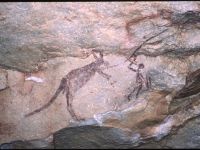It looks like you're using an Ad Blocker.
Please white-list or disable AboveTopSecret.com in your ad-blocking tool.
Thank you.
Some features of ATS will be disabled while you continue to use an ad-blocker.
share:
Trueman
SLAYER69
Additional images [/pic]Source
Egyptian kangaroo at nine o'clock ???
Naturalistic art style. Man spearing a kangaroo, Kimberley.
www.aboriginalculture.com.au...
It's the ancient Egyptian god Skippy.
What are they learning yous in skool these days, edumatacions not what it yoused to be.
reply to post by KnightLight
which makes me think it is a bird of some kind
You'd be exactly right....it's a vulture.
reply to post by deadcalm
I was thinking it was one, But that one in the image doesnt look like one much
I was thinking it was one, But that one in the image doesnt look like one much
Another fascinating thread. I firmly believe that part of Egypt will hold all sorts of, as yet, undiscovered wonders. Aside from the long history of
that region, it is also where the Egyptians fled following the Hyksos invasion (which nearly did for them).
You would therefore expect to find all sorts of very interesting stuff around there, ranging from tombs to monuments to evidence of a large scale military build up to reconquer (so the monuments should really be more of the chest thumping variety - look how good we are and what we can do).
I love the Kangaroo too......it definitely looks like one but i can't help thinking that is the style of depiction rather than a drawing of a kangaroo. Possibly deer or even some long extinct species. Historically, didn't the route to Nubia teem with Ibex? (Nubian rather than Alpine).
You would therefore expect to find all sorts of very interesting stuff around there, ranging from tombs to monuments to evidence of a large scale military build up to reconquer (so the monuments should really be more of the chest thumping variety - look how good we are and what we can do).
I love the Kangaroo too......it definitely looks like one but i can't help thinking that is the style of depiction rather than a drawing of a kangaroo. Possibly deer or even some long extinct species. Historically, didn't the route to Nubia teem with Ibex? (Nubian rather than Alpine).
reply to post by Flavian
Whats really sad imho is that due to the Aswan Dam we may never know if there were other yet to be discovered locations now flooded.
Whats really sad imho is that due to the Aswan Dam we may never know if there were other yet to be discovered locations now flooded.
reply to post by SLAYER69
Quite true. What is the really sad is the sheer number of dams being built / already built around such areas. We all know of the Aswan and Three Gorges Dam but there are loads of others.
Turkey is perhaps the worst offender (but then i suppose it could claim to have the most significant historical sites). For example, The Kestel Dam covered pottery workshops mentioned by Pliny. This is near Bergama. Also near Bergama is the Yortlani Dam, which covered the ancient site of Alliano, home to the Roman era's largest bathing complex (allegedly) and also the location (again allegedly) of the world's oldest thermal baths.
Possibly the worst of all though is the dam scheduled for Hasankeyf in the Tigris River basin (Turkey again). This site has been continuously inhabited for around 10'000 years so who knows what treasures will be lost for ever - possibly nothing but then possibly some finds of huge significance.
It's tough though. At the end of the day, water is essential and these areas are in serious need of both power and water supply.
Quite true. What is the really sad is the sheer number of dams being built / already built around such areas. We all know of the Aswan and Three Gorges Dam but there are loads of others.
Turkey is perhaps the worst offender (but then i suppose it could claim to have the most significant historical sites). For example, The Kestel Dam covered pottery workshops mentioned by Pliny. This is near Bergama. Also near Bergama is the Yortlani Dam, which covered the ancient site of Alliano, home to the Roman era's largest bathing complex (allegedly) and also the location (again allegedly) of the world's oldest thermal baths.
Possibly the worst of all though is the dam scheduled for Hasankeyf in the Tigris River basin (Turkey again). This site has been continuously inhabited for around 10'000 years so who knows what treasures will be lost for ever - possibly nothing but then possibly some finds of huge significance.
It's tough though. At the end of the day, water is essential and these areas are in serious need of both power and water supply.
Trueman
SLAYER69
reply to post by Trueman
I thought that was a bit odd. I'd like to see the whole pic to be sure.
Some people believe egyptians reached Australia, maybe they did after all.
Second row fifth image.
I'm going with the oriental bald ibis as a possibility, now if we could find a picture of the back end of this hieroglyph we will have an answer.
edit on 103131p://bWednesday2014 by Stormdancer777 because: (no reason given)
reply to post by SLAYER69
I was thinking it was one, But that one in the image doesnt look like one much
I agree somewhat...but what I think happened here was a transcription error when the craftsman was carving the figure...simply a spelling mistake if you will. It looks like it was originally carved as the symbol for the pheonetic sound "f"...a snake with antennae...or it could be the symbol for "a" ....when the carver realized his mistake he fixed it which is why his vulture has what looks like horns.
Thats my guess anyway.
edit on 5-3-2014 by deadcalm because: (no reason given)
reply to post by Stormdancer777
I'm going with the oriental bald ibis as a possibility, now if we could find a picture of the back end of this hieroglyph we will have an answer.
I agree...without seeing it in context, it's hard to know what the carvers intention was. I definitely don't think it's a kangaroo.
It's a Jerboa - common in north Africa and that was one was probably a Jaculus orientalis
Always good when they find new stuff.
Always good when they find new stuff.
999zxcv
weirdguy
Trueman
reply to post by weirdguy
I don't see similarity between the "Slayer's Egyptian Kangaroo" (new coined term...hehe), and any of the birds on your pic.
There were actually marsupials in Egypt
secretvisitors.wordpress.com...
that was interesting
what next Hippopotomus and tiger's getting found in London [ wait they did ]
The Egyptian Jerboa?
www.mnh.si.edu...
If there were sabre-tooth tigers and mammoths, perhaps there were giant Jerboa? To think that at the time that this tomb was constructed, the North Sea didn't exist, Northern Europe was covered in an ice sheet, and England had a population of 6000.
www.telegraph.co.uk...
How different the world must have been.
edit on 6-3-2014 by stormcell because: (no reason given)
new topics
-
Scary video of face in an abandoned house
Paranormal Studies: 1 hours ago -
Just Came Across These Unusual Old UFO Pics
Aliens and UFOs: 3 hours ago -
LA Mayor Bass Demanded $49M in Additional LAFD Cuts One Week Before Wildfires
Mainstream News: 5 hours ago -
Sepultura - Territory - With New Drummer Greyson Nekrutman
Music: 6 hours ago -
Carry On!
Short Stories: 6 hours ago
top topics
-
This should be plastered all over the airwaves
Mainstream News: 12 hours ago, 23 flags -
LA Mayor Bass Demanded $49M in Additional LAFD Cuts One Week Before Wildfires
Mainstream News: 5 hours ago, 17 flags -
Archbisop Vigano Warns of Deep State and Deep Church
New World Order: 14 hours ago, 16 flags -
Oh, Good Gosh. “Kremlin Warns Stay Away from Greenland.”
World War Three: 14 hours ago, 11 flags -
Just Came Across These Unusual Old UFO Pics
Aliens and UFOs: 3 hours ago, 4 flags -
Carry On!
Short Stories: 6 hours ago, 3 flags -
Sepultura - Territory - With New Drummer Greyson Nekrutman
Music: 6 hours ago, 2 flags -
Scary video of face in an abandoned house
Paranormal Studies: 1 hours ago, 2 flags
active topics
-
Trump says ownership of Greenland 'is an absolute necessity'
Other Current Events • 161 • : Imhere -
Dr. Demento
Music • 16 • : baddmove -
Los Angeles brush fires latest: 2 blazes threaten structures, prompt evacuations
Mainstream News • 365 • : Wookiep -
Statements of Intent from Incoming Trump Administration Members - 2025 to 2029.
2024 Elections • 64 • : WeMustCare -
This should be plastered all over the airwaves
Mainstream News • 54 • : fringeofthefringe -
Archbisop Vigano Warns of Deep State and Deep Church
New World Order • 9 • : CosmicFocus -
Post A Funny (T&C Friendly) Pic Part IV: The LOL awakens!
General Chit Chat • 8015 • : baddmove -
Carry On!
Short Stories • 2 • : JJproductions -
Scary video of face in an abandoned house
Paranormal Studies • 0 • : ColeYounger2 -
Oh, Good Gosh. “Kremlin Warns Stay Away from Greenland.”
World War Three • 30 • : ARM19688


